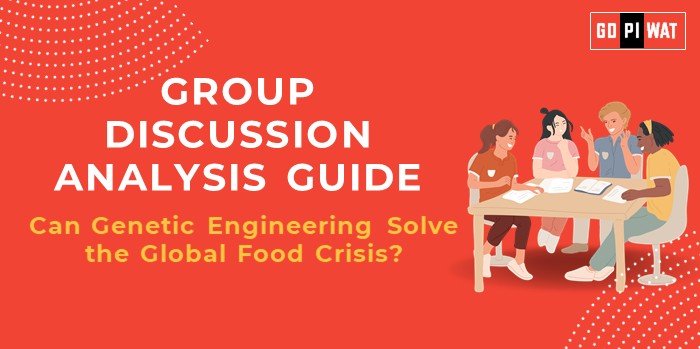📋 Group Discussion (GD) Analysis Guide
🌾 Can Genetic Engineering Solve the Global Food Crisis?
🌐 Introduction
- Context Setting: The global food crisis affects millions, with hunger rising despite technological advancements. Genetic engineering (GE) offers hope by enhancing crop yields, improving nutrition, and mitigating climate challenges.
- Topic Background: Although GE technology has existed since the 1970s, its agricultural applications gained momentum with innovations like CRISPR. However, challenges like public skepticism and regulatory bottlenecks hinder widespread adoption.
📊 Quick Facts and Key Statistics
- Global Hunger: 320 million Indians sleep hungry each night, despite producing 300 million metric tons of food annually.
- Food Waste: India wastes 74 million tonnes of food annually, 22% of its foodgrain output.
- Yield Boost: RNA-targeted genetic modifications have increased rice and potato yields by 50%, with added drought tolerance.
- Adoption Rate: GE crop trials in India include maize, mustard, and rice, but regulatory and public resistance limits broader adoption.
👥 Stakeholders and Their Roles
- Governments: Implement policies to support GE research, streamline regulations, and ensure safety.
- Farmers: Pilot GE crops to maximize productivity and adapt to climate challenges.
- Biotech Companies: Develop technologies like RNA-based gene editing and pest-resistant crops.
- Consumers: Drive market demand and acceptance through purchasing decisions.
- Activists and NGOs: Advocate for or against GE crops, emphasizing environmental or ethical considerations.
✨ Achievements and Challenges
✅ Achievements
- Yield Improvement: GE crops like Golden Rice enhance both productivity and nutrition.
- Drought Resistance: GE crops withstand harsh climates, enabling farming in marginal areas.
- Resource Efficiency: Bt cotton has significantly reduced pesticide use in India.
⚠️ Challenges
- Regulatory Hurdles: Prolonged approval timelines delay GE adoption.
- Public Skepticism: Fears over safety and ethical concerns deter GE crop acceptance.
- Food Waste: Despite advancements, 74 million tonnes of food is wasted annually, undermining potential benefits.
🚀 Effective Discussion Approaches
- Opening Approaches:
- Use impactful data: “320 million Indians face hunger daily; can GE solve this crisis?”
- Frame a question: “How can we balance GE’s potential benefits with public concerns?”
- Counter-Argument Handling:
- “While concerns about biodiversity loss exist, new RNA-targeted technologies offer precision with minimal risks.”
- “Regulatory delays are valid, but global precedents like Brazil demonstrate success when policies align with innovation.”
🔍 Strategic Analysis of Strengths and Weaknesses
- Strengths: High yield potential, climate resilience, reduced reliance on pesticides.
- Weaknesses: Ethical dilemmas, public resistance, regulatory delays.
- Opportunities: Technological advancements, climate adaptation strategies.
- Threats: Misinformation campaigns, economic disparities in adoption.
📑 Structured Arguments for Discussion
- Supporting Stance: “GE can enhance crop yields by 50%, combatting hunger and waste.”
- Opposing Stance: “The ecological risks and regulatory bottlenecks of GE outweigh its benefits.”
- Balanced Perspective: “GE holds promise, but equitable implementation and safety are key to its success.”
📌 Connecting with B-School Applications
- Real-World Applications: Analyze the economic impact of GE, food supply chains, and resource management.
- Sample Interview Questions:
- “How can India overcome regulatory barriers to GE adoption?”
- “What lessons can India learn from global GE practices?”
- Insights for B-School Students: Investigate GE’s impact on food security and environmental sustainability.


